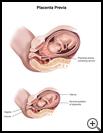
Placenta Previa
________________________________________________________________________
KEY POINTS
- Placental previa means that the placenta is in the lowest part of the uterus, covering all or part of the opening to the uterus (cervix). Placenta previa can cause severe bleeding and can be very serious for the mother and baby.
- Treatment depends on how much bleeding you have had and how far along you are in the pregnancy. You may need to stay on bed rest at home and take medicines to stop contractions. You may need a C-section to deliver the baby.
- Follow your healthcare provider's instructions about how to take care of yourself at home.
________________________________________________________________________
What is placenta previa?
Placental previa means that the placenta is in the lowest part of the uterus, covering all or part of the opening to the uterus (cervix). The placenta is tissue that is attached to the inside of the uterus and is attached to the baby by the umbilical cord. It carries oxygen and food from your blood to the baby’s blood.
Placenta previa can cause severe bleeding and can be very serious for the mother and baby.
What is the cause?
Placenta previa happens when the fertilized egg attaches to the lower part of the uterus instead of to the top or side of the uterus. This can result in a placenta that is over the cervix. Often, as the uterus grows during the first 3 months of pregnancy, the placenta moves away from the opening of the uterus. If the placenta does not move up and out of the way, it is called previa.
You have a higher risk for placenta previa if you:
- Are older than 35
- Smoke
- Have given birth more than once
- Have had many terminations of pregnancy (abortions)
- Are carrying twins
- Have had a C-section (a surgery that delivers your baby through a cut in your belly and uterus)
- Have had placenta previa before
What are the symptoms?
The most common symptom is heavy, bright red vaginal bleeding that starts suddenly in the last few months of pregnancy. There is usually no pain, tenderness, uterine contractions, or cramps.
How is it diagnosed?
Your healthcare provider will ask about your symptoms and medical history and examine you. You may have tests such as:
- Blood tests
- An ultrasound, which uses sound waves to show pictures of your uterus, the baby, and the tissue and fluid that surround your baby
- A nonstress test, which uses a monitor strapped your belly to record how your baby's heart rate changes when your baby moves
- A biophysical profile, which uses sound waves (ultrasound) along with a nonstress test to check the baby's breathing, movements, heart rate, and muscle tone.
How is it treated?
Treatment depends on how much bleeding you have had and how far along you are in the pregnancy.
If it is before 37 weeks in the pregnancy and you have not lost a lot of blood, your healthcare provider may recommend or prescribe:
- Bed rest at home or in the hospital
- Iron pills
- Medicine to stop contractions if you have bleeding caused by contractions of the uterus
If you have lost a lot of blood, you may need a blood transfusion and your baby may need to be delivered early. If you have severe bleeding, the baby is usually delivered by C-section.
If you start having bleeding after 37 weeks of pregnancy and the placenta does not completely cover the opening to the uterus, you may be able to have a vaginal delivery. You will be monitored closely for increased bleeding or problems. At the first sign of increased bleeding you may need a C-section to deliver the baby.
If the placenta completely covers the opening of the uterus, a C-section is the only way to deliver the baby safely.
How can I take care of myself?
- Follow your healthcare provider's instructions. Ask your provider:
- How and when you will get your test results
- How long it will take to recover
- If there are activities you should avoid and when you can return to your normal activities
- How to take care of yourself at home
- What symptoms or problems you should watch for and what to do if you have them
- Make sure you know when you should come back for a checkup.

